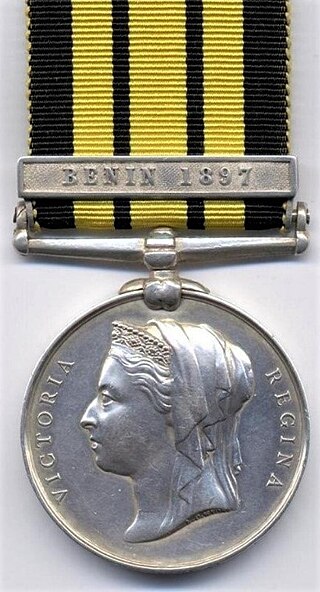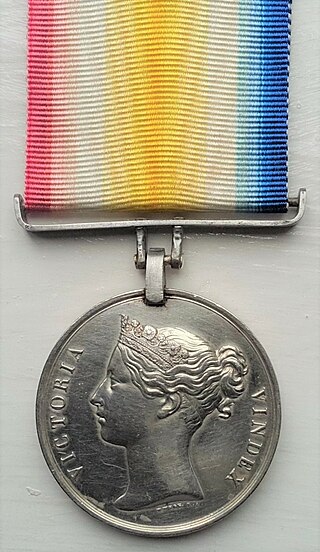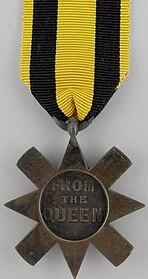
The 1914 Star, colloquially known as the Mons Star, is a British World War I campaign medal for service in France or Belgium between 5 August and 22 November 1914.

The South Africa Medal (1853) is a campaign medal instituted in 1854, for award to officers and men of the Royal Navy, British Army and locally recruited Cape Mounted Riflemen, who served in the Cape of Good Hope during the Xhosa Wars between 1834 and 1853.

The Cape of Good Hope General Service Medal is a British campaign medal which was awarded to members of the Cape Colonial Forces who took part in three campaigns in and around the Cape of Good Hope, in Basutoland in 1880–1881, in Transkei in 1880–1881 and in Bechuanaland in 1896–1897.

The King's South Africa Medal is a British campaign medal awarded to all British and Colonial military personnel who served in the Second Boer War in South Africa, and who were in the theatre on or after 1 January 1902 and who had completed 18 months service in the conflict prior to 1 June 1902.

The British South Africa Company Medal (1890–97). In 1896, Queen Victoria sanctioned the issue by the British South Africa Company of a medal to troops who had been engaged in the First Matabele War. In 1897, the award was extended to those engaged in the two campaigns of the Second Matabele War, namely Rhodesia (1896) and Mashonaland (1897). The three medals are the same except for name of the campaign for which the medal was issued, inscribed on the reverse.

The East and Central Africa Medal, established in February 1899, was a British campaign medal awarded for minor military operations in the Uganda Protectorate and Southern Sudan between 1897 and 1899. Four separate clasps were issued.

The East and West Africa Medal, established in 1892, was a campaign medal awarded for minor campaigns that took place in East and West Africa between 1887 and 1900. A total of twenty one clasps were issued.

The Waterloo Medal is a military decoration that was conferred upon every officer, non-commissioned officer and soldier of the British Army who took part in one or more of the following battles: Ligny, Quatre Bras and Waterloo.

The Queen's Mediterranean Medal was authorised by King Edward VII and was awarded to Militia troops who had replaced their regular Army counterparts in the various military garrisons across the Mediterranean, in Gibraltar, Malta and Egypt. This allowed regular troops to be available for the Second Boer War.

The South Africa Medal (1880), often referred to as the Zulu War Medal, is a campaign medal instituted in 1880 and awarded by the British Government to members of the British Army, Royal Naval Brigade and Colonial Volunteers who were involved in a series of South African tribal wars in the Cape of Good Hope, Colony of Natal and Transvaal between 1877 and 1879, most notably for the Anglo-Zulu War of 1879.

The Candahar, Ghuznee, Cabul Medal was awarded to those who took part in the campaign in the spring and summer of 1842, under the command of General William Nott, to restore British standing in Afghanistan after earlier defeats during the First Anglo-Afghan War.

The Africa General Service Medal, established in 1902, was a campaign medal of the United Kingdom. It was awarded for minor campaigns that took place in tropical Africa between 1900 and 1956, with a total of forty five clasps issued. The medal is never seen without a clasp and some are very rare. Most medals were granted to British led local forces, including the King's African Rifles and the West African Frontier Force. The only campaigns where European troops were present in any numbers were the various Somaliland campaigns,, and in Kenya.

The Egypt Medal (1882–1889) was awarded for the military actions involving the British Army and Royal Navy during the 1882 Anglo-Egyptian War and in the Sudan between 1884 and 1889.

The Queen's Sudan Medal was authorised in March 1899 and awarded to British and Egyptian forces which took part in the Sudan campaign between June 1896 and September 1898.

The Ashantee Medal is a British campaign medal instituted on 1 June 1874. It was awarded to British, Colonial and allied native forces, under the command of Major General Sir Garnet Wolseley, who were deployed against the army of the Ashanti King Kofi Karikari, during the Third Anglo-Ashanti War, June 1873 to February 1874.

The Ashanti Medal was sanctioned in October 1901 and was the first campaign medal authorised by Edward VII. This medal was created for those troops engaged in the Third Ashanti Expedition, also known as the War of the Golden Stool. This expedition lasted from March – December 1900, with the final outcome that the Ashanti maintained its de facto independence. Ashanti was made a Protectorate of the British Empire, but they ruled themselves with little reference to the colonial power.

The Kelat-I-Ghilzie Medal is a campaign medal issued by the British East India Company, to the defenders of the fort at Kelat-I-Ghilzie during the First Anglo-Afghan War.

The Central Africa Medal was a British campaign medal awarded for service from 1891 to 1894 in Eastern and Central Africa, and from 1894 to 1898 for service in British Central Africa.

The Khedive's Sudan Medal was a campaign medal awarded by the Khedivate of Egypt to both Egyptian and British forces for service during the reconquest of the Sudan, the final part of the Mahdist War. Established 12 February 1897 by Khedive Abbas Hilmi Pasha, this medal was initially to commemorate the reconquest of the Dongola province in 1896. It was subsequently authorised for later campaigns and actions until 1908. The medal was awarded with fifteen different clasps.

The Volunteer Long Service Medal was instituted in 1894 as an award for long service by other ranks and some officers of the United Kingdom's Volunteer Force. Award of the medal was discontinued when it was superseded by the Territorial Force Efficiency Medal in 1908.





















